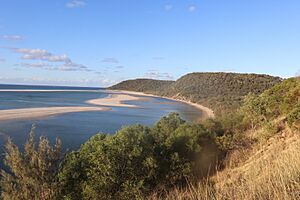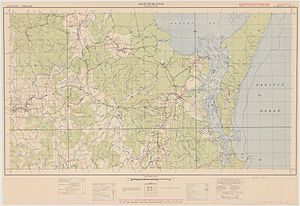Double Island Point facts for kids
Double Island Point is a special piece of land that sticks out into the ocean in Queensland, Australia. It's located just north of Noosa and is part of the amazing Great Sandy National Park. This area is known for its stunning beaches and natural beauty.
The famous explorer Captain Cook named this point on May 18, 1770. He called it "Double Island Point" because of its unique shape, even though there aren't actually two islands there!
Contents
Geography of Double Island Point
Even though its name suggests two islands, Double Island Point is actually a sandspit. This means it's a long, narrow strip of sand that extends from the mainland into the water. It marks the southern edge of a large area of water called Wide Bay.
You can't get to Double Island Point by regular car. The only way to reach it is by four-wheel drive vehicle, driving along the beach. You can start your adventure from Rainbow Beach to the north, or take a longer trip from Noosa Heads to the south. If you come from Noosa, you'll need to take a ferry across the Noosa River first!
Surfing at the Point
The northern side of Double Island Point is a very popular spot for surfing. When the waves are just right, surfers can enjoy a long ride, sometimes for as much as 300 meters! It's a fantastic place for those who love to catch waves.
Record Wind Gust
On December 16, 2006, the weather station at the Double Island Point Lighthouse recorded an incredibly strong wind gust. It reached 196 kilometers per hour (about 121 miles per hour)! This powerful gust came from a severe supercell thunderstorm. It was the strongest non-tornado wind gust ever recorded from a thunderstorm in Australia. The winds were as strong as those you'd find in a Category 3 tropical cyclone!
The Double Island Point Lighthouse
A lighthouse was built on Double Island Point in 1884. This lighthouse is made of timber with metal covering, which was a common and cheaper way to build lighthouses in Queensland. This design was also good because it worked well on the soft, sandy ground.
The lighthouse was originally planned to be built halfway up the point. However, people soon realized that the light wouldn't be seen clearly from the north if it was placed there. So, they decided to build the tower right on top of the highest part of the point instead.
When it was first built, the lantern in the lighthouse burned oil. In 1923, it was updated to use vaporized kerosene. Later, it was changed again to run on electric power. In 1992, the lighthouse was converted to use solar power, and it no longer needed people to live there and operate it. Today, the light flashes once every 7.5 seconds, and its light source is 96 meters (about 315 feet) above sea level, helping ships navigate safely.



